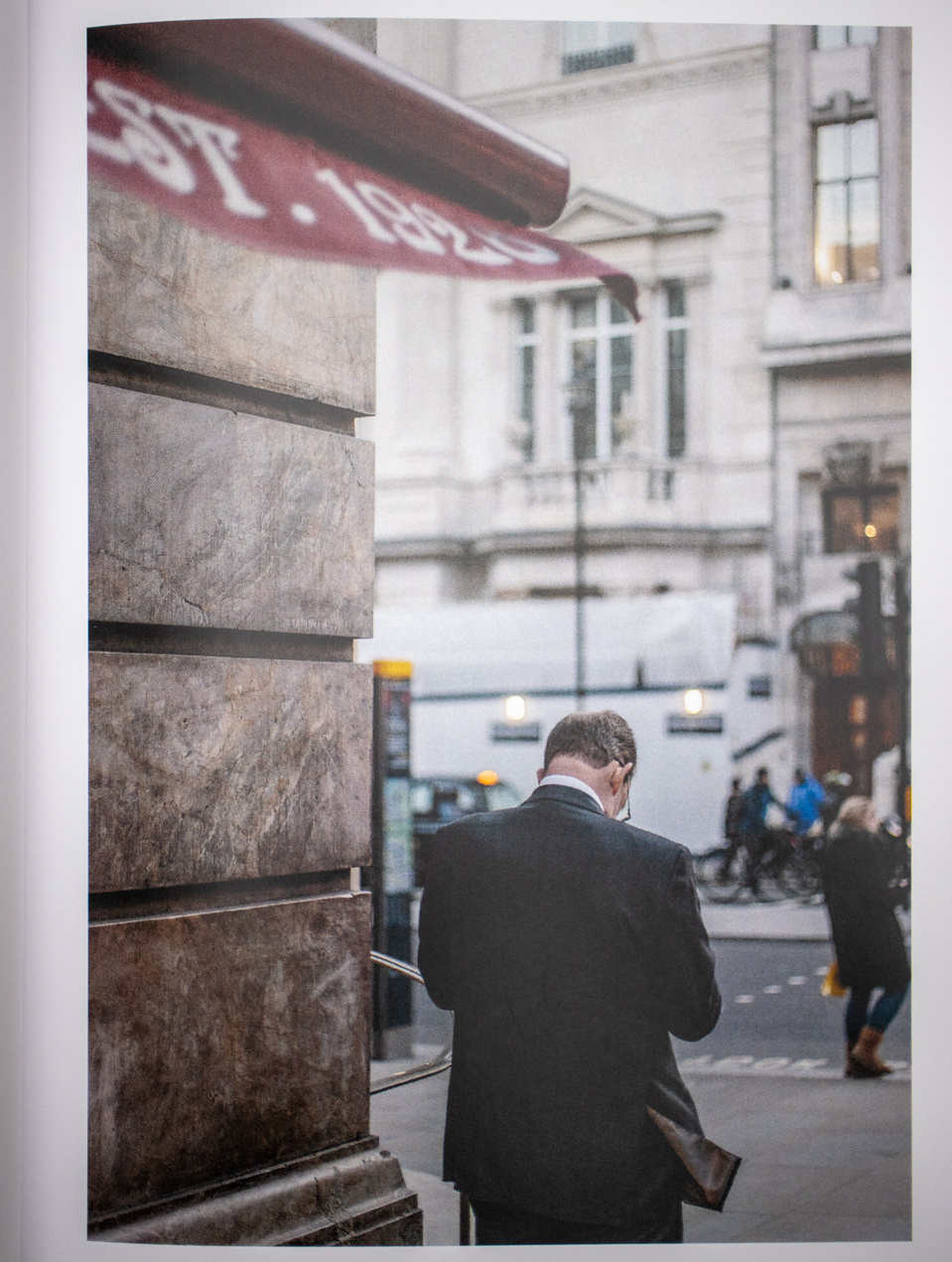Fine Airs & Fine Graces by Shane Taylor
November 26, 2020First Published in 2020
Fine Airs & Fine Graces is London based street photographer Shane Taylor’s second book and part of a welcome trend toward self published monographs, enabled by print on demand platforms and Shopify. I bought Shane’s book directly from his website after seeing it on Instagram. Included in the package was a hand written postcard, a couple of 5x7 prints (which I was able to select while ordering the book) and a printed artist statement and bio. All nice, personal touches.
The book has no introduction and, given his prominence among the current wave of London street photographers, on who his style has exerted a clear influence, perhaps it doesn’t need one.
Shane (@heroesforsale), Joshua K. Jackson (@joshkjack), Craig Whitehead (@sixstreetunder), Josh Edgoose (@spicy.meatball), Alex Motoc (@alexmotoc), Simon King (@simonking_v), and Nick Turpin (@the_nick_turpin) are photographers who have been documenting London both prior to and during the current times of pandemic and social upheaval. Seeing their work on a longer timeline underscores the value of street photography, that despite the controversy that sometimes surrounds it, and affirms its validity as a genre when viewed through the lens of history. It provides a document of a specific time and place, capturing the vernacular of fashion, architecture, technology and the prevailing social climate.
Shane’s style has its roots in the history of street photography and within them one sees a blurry line between that history and the present. In various interviews (sources at the bottom of this post) he cites Robert Frank, William Eggleston, Harry Callahan and Larry Fink as influences. The hallmarks of Shane’s style are subtly observed human details, isolated thanks to shallow depth of field that hints at their context and accentuated by a warm, almost autumnal colour grading that lends the images a sense of timelessness (were it not for the smartphones that his subjects sometimes wield).
Shane is active on Instagram (where he has over 100k followers), doing frequent AMAs and actively talks about his technique, equipment choices and why he’s shooting with a particular camera or lens. He co-hosts Framelines on YouTube where he continues these discussions around equipment and techniques - my favourite segments are the ones where he and his co-host Josh Edgoose strap on GoPros and take us on a point of view journey as they shoot. They intercut raw footage from the streets with the final images they captured at a given moment, while voicing over commentary - it offers real insight into how they work and even yields the occasional celebrity sighting.
He shoots both film and digital - though more of the former recently - and often makes non-traditional choices such as using larger (D)SLRs for street photography - when many photographers prefer more discreet cameras - and longer focal lengths, such as 85mm, whereas wider focal lengths between 28mm - 50mm are the more typical range of street photographers. It was an interview with Shane that put me onto using 85mm more in my own work.
In that interview with Fujilove Shane discusses this choice, “In following what interested me, I developed a style of intimate street photography. I kept seeking out shots where I could fill the frame with a gesture or expression- rarely shooting full bodies or including much of the environment. That led me to seek out longer focal lengths. I moved from 28mm all the way to 85mm over the period of 2 years. I felt I could never get close enough to people with wide lens, despite sometimes being inches away from them.”
In this use of longer focal lengths, as with other elements of his style, notably how he uses colour, Shane’s work recalls that of Saul Leiter, who took these techniques even further, using focal length and colour in combination to push his work toward abstraction.
It’s the second book I’ve reviewed here that opens with an image of a bird. But whereas Bill Brandt’s The English at Home opens with a seagull - the setting could be urban or coastal - in full flight, Fine Airs & Fine Graces opens with that most urban of birds, a scruffy pigeon huddled in a doorway against the cold, shooting the viewer a pissed off look.
The next two images reveal Shane’s eye for subtle details: the ladder in a pair of tights, breeze that blows through both a restaurant canopy and vent of a man’s suit.
Many images feature subjects who are aware that they are being or have just been photographed. This is something that Shane talks about and also addresses in the captions of his posts.
“For me, I like to get inside people’s heads. I’m fascinated by how my camera can capture an expression or gesture of a complete stranger. Someone I’ll never talk to. Whose name or political leanings I’ll never know. My camera leaps over that huge barrier of social bullshit and right into their laps. There it is, recorded, a relatable little moment where I begin to empathise with that person. I feel closer to them, and by extension, closer to humanity.” Shane said, in the same interview in Fujilove.
Fine Airs & Fine Graces is totally accessible and a book I’ll likely return to often. There’s no pretence to the photographs within it. They capture fleeting moments of humanity within an urban setting from which they are slightly abstracted, but which is clearly of their making. Contemplative and sincere, I look forward to seeing how Shane’s work continues to evolve.
I’ll leave you with this striking image:
More about Shane Taylor
Follow him on Instagram @heroesforsale
Watch his YouTube show Framelines
Read his profile in The Guardian
Interviews with him in:









